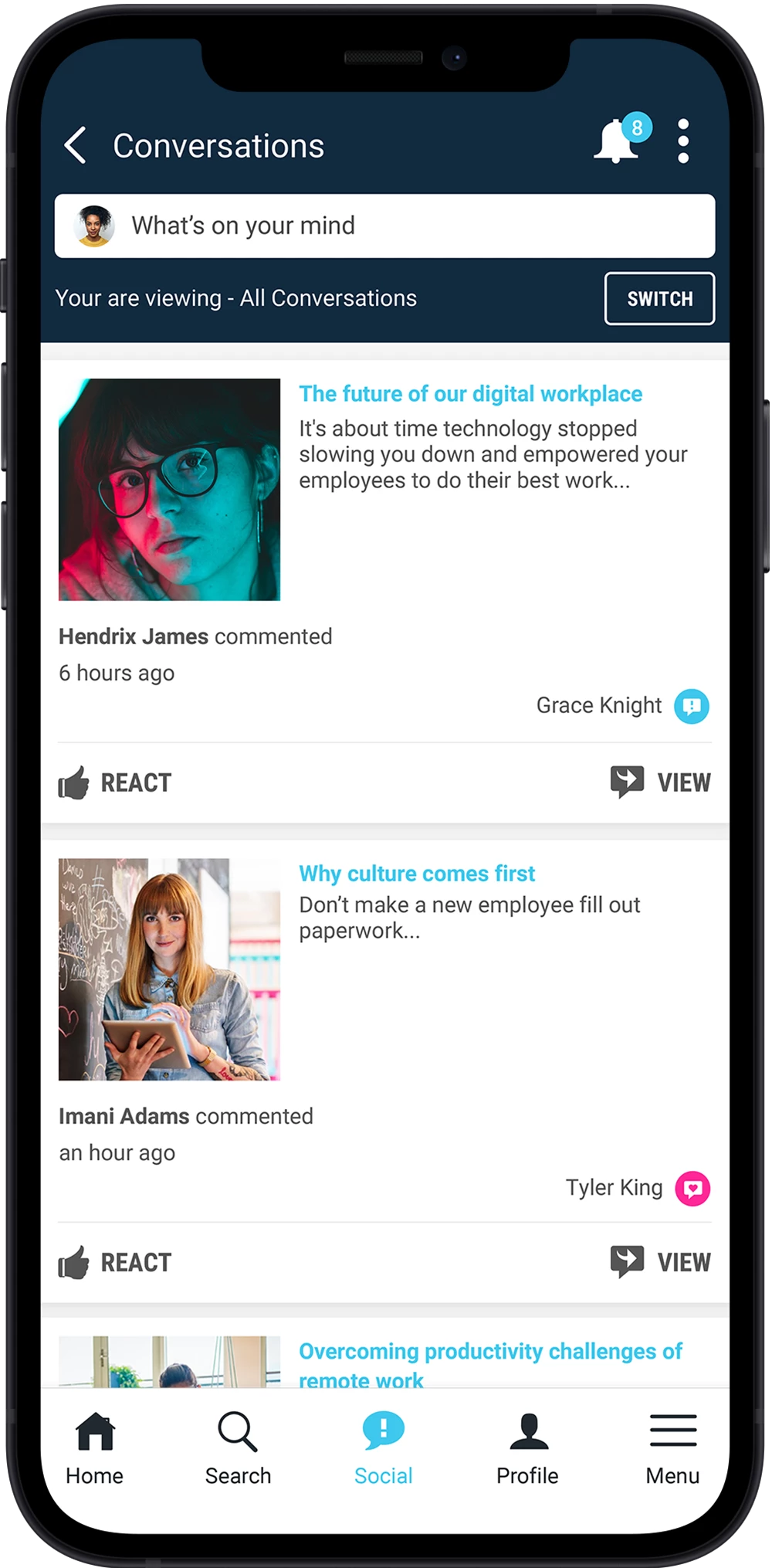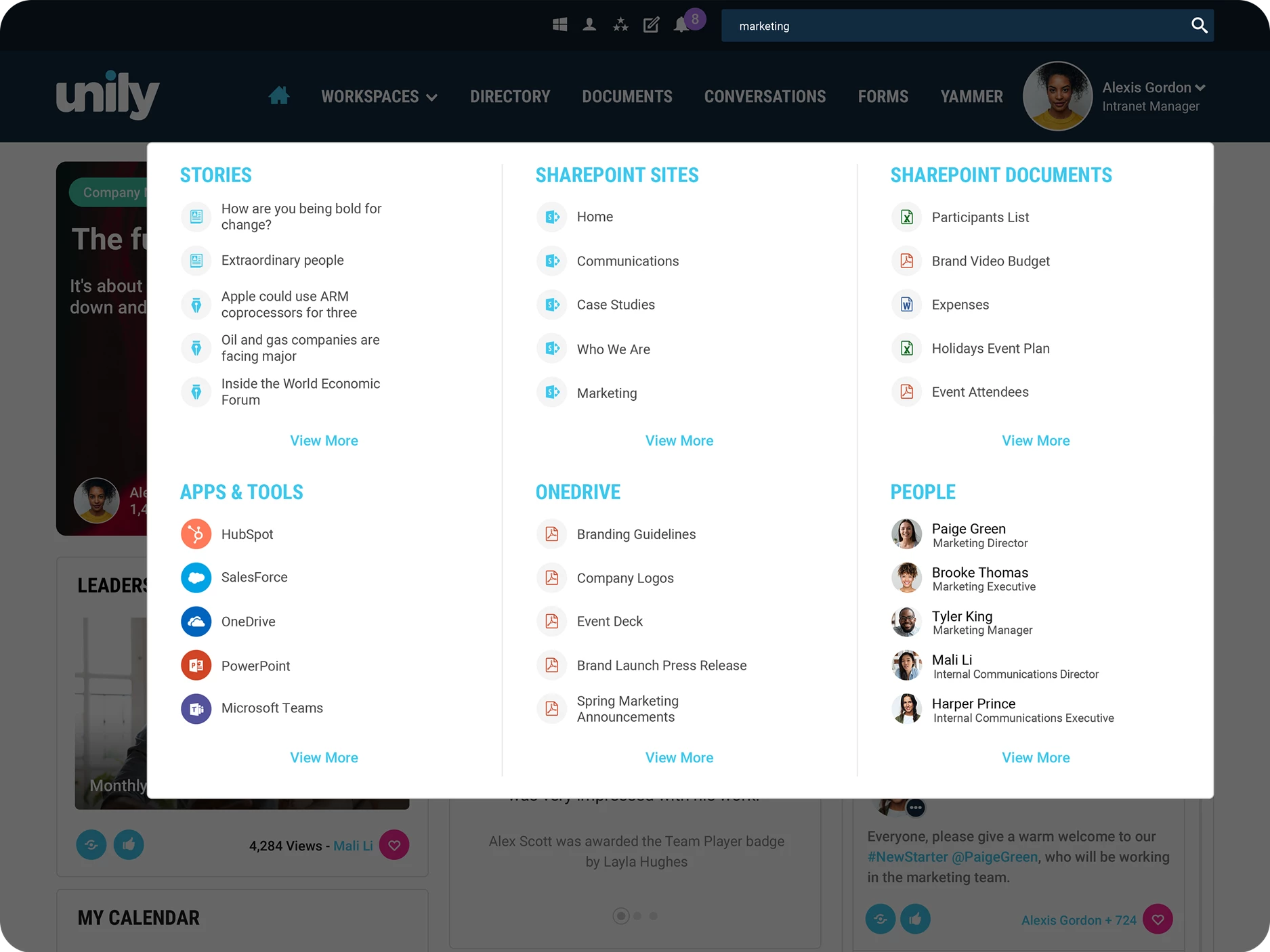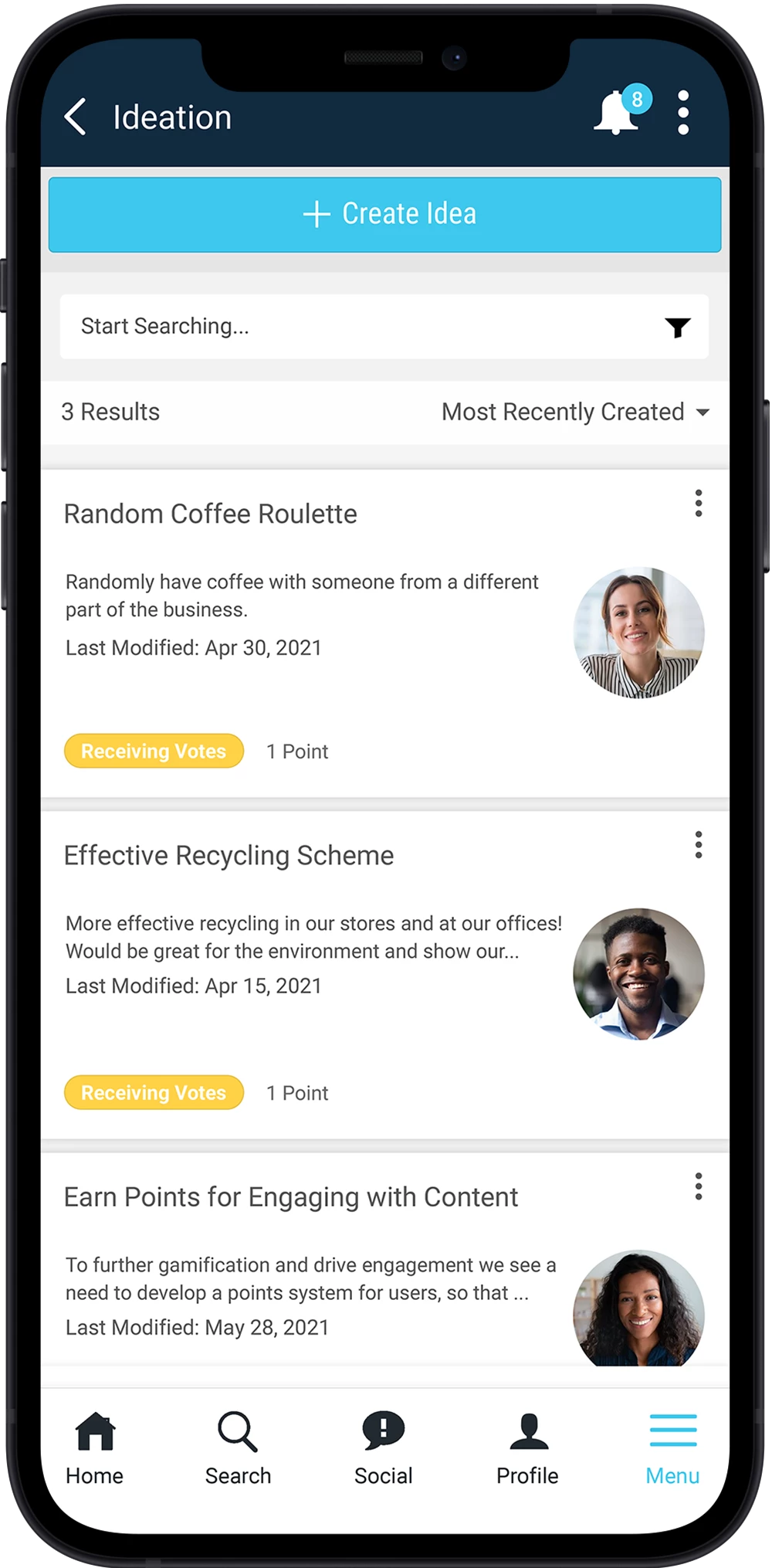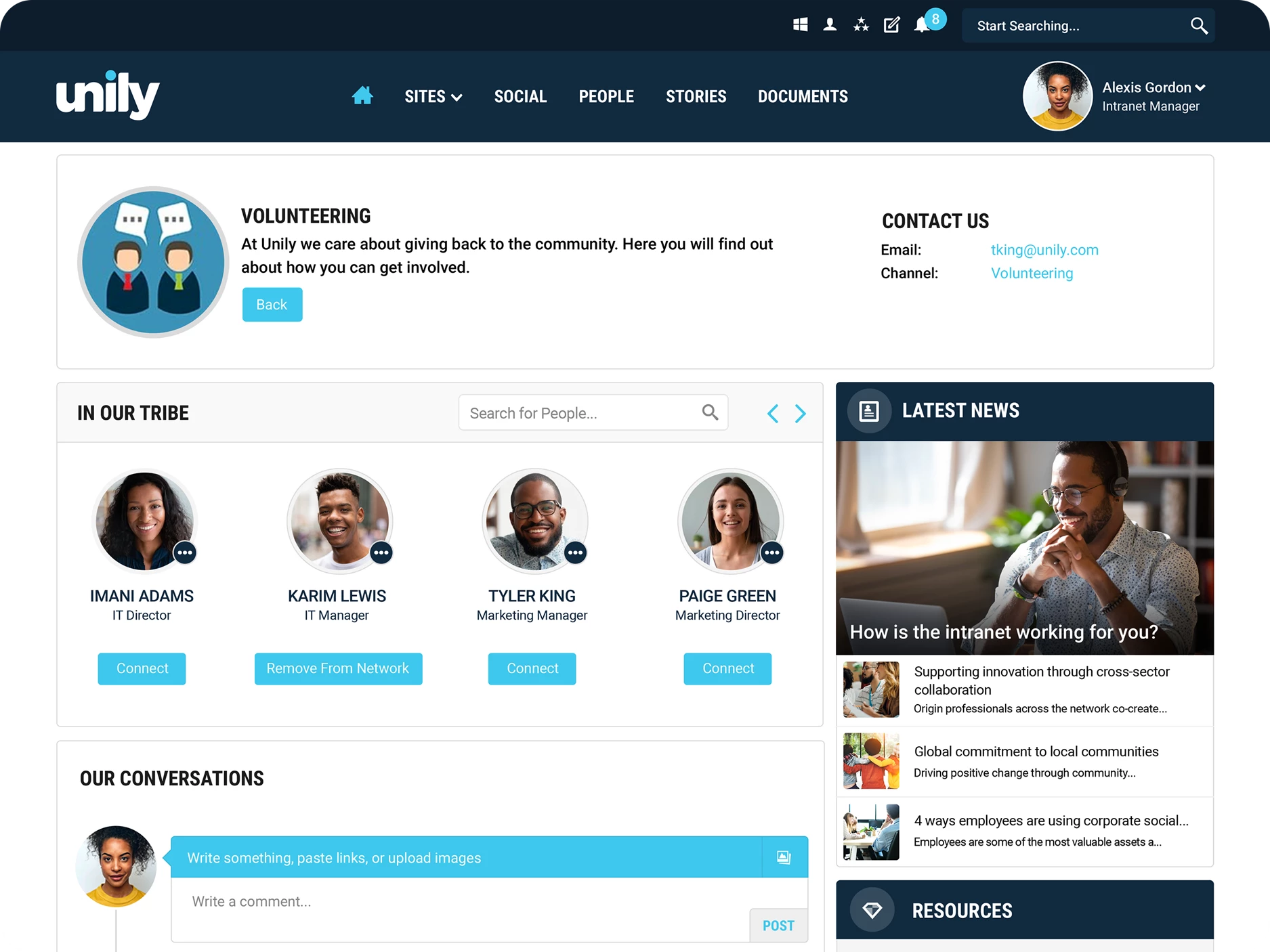How internal comms can refuel collaboration in a hybrid workplace
From more flexible hours to reduced commutes, working from home has many benefits—but collaboration typically isn’t one of them. According to MIT research, remote work causes employees’ collaboration networks to become more static and siloed, with fewer bridges between disparate parts of the organization. Fortunately, internal communications teams have a new secret weapon for breaking down barriers and fueling knowledge sharing practices that span the entire enterprise: the company intranet.

Why collaboration matters
Collaboration is part of every successful organization’s DNA. No business can turn new ideas into realities without bringing employees from multiple teams together to execute their product vision. A Stanford study found that even the perception of working together on a task can supercharge performance—with participants who were primed to act collaboratively sticking with their projects 64% longer than their solitary peers. They also reported higher engagement levels, less fatigue, and better success rates.
Research from the Institute for Corporate Productivity reveals findings that are similarly impressive, uncovering that companies that promoted collaborative work were 5 times as likely to be considered high performing. In contrast, companies that fail to work together effectively are likely to suffer miscommunications and knowledge gaps that can delay internal processes and hinder results. In fact, 86% of executives point to ineffective collaboration and communication as a major cause of failure in business.
How remote working is impacting collaboration
Years after the onset of the COVID-19 pandemic kicked the world’s largest work from experiment into action, new studies are shedding light on how this shift is impacting workforce collaboration. After surveying over 61,000 employees, Microsoft revealed that firm-wide remote work can cause business groups within their company to become less interconnected. It also reduced the number of ties bridging structural holes in the company’s informal collaboration network and caused individuals to spend less time working with their peers. Overall, remote work caused employees to spend about 25% less of their time collaborating with colleagues across groups compared to pre-pandemic levels.
In addition to reducing the amount of collaborative work that employees engage in, remote working can also shrink an employee’s network of potential collaborators. When workers spend most of their time at home and are dispersed from their colleagues, they may not know who to turn to for input or feedback, especially if these peers sit in other functions or departments. Microsoft’s research found that while remote workers tended to communicate more frequently with people within their inner network, these employees were slower to add new collaborators into the mix.
What can internal communicators do to turn remote collaboration practices around?
Given Gartner’s prediction that 39% of global knowledge workers will work hybrid by the end of the year, it’s clear that eliminating work-from-home schemes isn’t the answer to today’s collaboration challenges. Instead, it’s up to organizations to equip their people with the tools and channels needed to share knowledge seamlessly, regardless of where an employee is working from.
Rather than viewing physical office spaces as the environment where collaboration takes place, enterprises must recognize that it’s actually the digital workplace that’s now the home for exchanging ideas and knowledge. Increasingly, organizations are turning to their intranet to support borderless collaboration, which puts internal comms in the driving seat when it comes to enabling collaborative practices to thrive in a physically disconnected workplace.
Already leading enterprises are making waves in this space. ADP, a global provider of cloud-based human capital management (HCM) solutions, has transformed its employee experience platform into a home for idea sharing.
"We’ve been able to create a really open community where people are able to share their learnings and create engaging content for their peers"
Most critical to their collaboration strategy has been the ideation portal. 58k associates are able to input new ideas for improving anything from product to process right the way through to company culture. Colleagues can vote on their favorite ideas and the ideas that gain the most favorable responses are put forward for executive consideration.
ADP associates are also empowered to create their own articles to share knowledge and insights with their internal communities. Leveraging the full power of a social intranet means that employees can post comments to ask content authors for clarification on the insights shared or offer up additional perspectives to bolster the information available.
"If somebody has more questions or they want to ask the author something, they don't need to email them they can just comment directly and they get the answer"
A community of knowledge managers then works to map these insights into intuitive knowledge centers, which allow colleagues to easily search for employee-generated answers to common problems. The knowledge centers are continually monitored to ensure the most up-to-date information is surfaced and categorized in a way that is simple for employees to access. In this way, ADP is building a collaborative community that empowers its people to share and learn from a pool of continuously evolving crowd-sourced knowledge.
6 features to turn your intranet into the home of collaboration
To follow in the footsteps of organizations like ADP, there are a number of ways to transform the company intranet into a powerful tool for remote collaboration.
#1. Social
Beyond sharing technical knowledge, collaboration gives employees the opportunity to build meaningful relationships with their peers. To cultivate a sense of connection across the digital workplace, intranets include a variety of social features that mimic the way ideas are exchanged in a traditional office setting. In addition to features like reacting, commenting, and sharing content, employees can craft their own digital identities through rich user-profiles, allowing their peers to get a better idea of who they are and how they can collaborate.

#2. Centralized news
For collaboration to be effective, employees need a shared understanding of what’s going on in the business and the objectives the enterprise is trying to achieve. A modern intranet serves as a single destination for all the company news that employees need to know to do their best work. If there’s an update that’s crucial for employees, internal comms teams can even make it mandatory to ensure everyone reads it and track when people have finished the article.

#3. Integrated knowledge repositories and effective search
Unlike office work, employees who are working from home can’t tap someone on the shoulder and ask them where to find the information they’re looking for. Fortunately, employee experience platforms can offer the digital equivalent of that by providing a Google-like search experience that unifies all content and data in one place. Search results are pulled from all repositories, making it easy for employees to surface key information, regardless of where it might be sitting within their digital workplace.

#4. Ideation
All too often employees have great ideas for improving a product or process, yet fear or uncertainty about how to voice these suggestions holds them back. Rather than letting potentially revolutionary innovations go unheard, leaders are harnessing ideation features on their intranet to give all employees a platform to share their thoughts.

#5. Mobile accessibility
Part of what makes intranets such a valuable knowledge sharing tool is their ability to break down traditional collaboration barriers—including computer access. Thanks to mobile apps with push notifications, employees can offer their input and share knowledge with their peers at any time, even if they’re miles away from the office or their remote work setup.

#6. Sites
In addition to connecting through social functionality, employee experience platforms can also host sites dedicated to a specific group of employees or for a project team. This creates a singular destination for all content and communications related to the initiative, making it easy for employees to share documents, connect with their collaborators, and provide updates on the task they’re working together to complete.

Take remote collaboration to the next level with a next-generation intranet
Since it’s clear that remote and hybrid working are here to stay, organizations need to get creative to develop new strategies and channels that will drive knowledge sharing across all locations and time zones. To learn more about how your enterprise can harness an employee experience platform to improve collaboration for remote and in-office employees alike, get started with a free demo today.

















